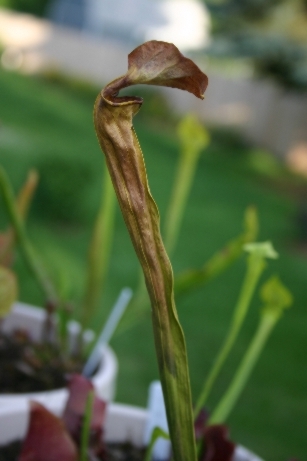Question Dried Sarr
Dried Sarr
QUESTION: Hi have some Sarrs that the pitchers are becoming very dried. I notice no insect type damage. They are sitting in plenty of rainwater in proper CP soil media. Other sarrs in the area seem to be doing fine. Could it be some sort of fungus? If it is what do I look for? Photo attached
Thanks Much
Bud
ANSWER: Hi Bud,
Thank-you for sending the picture. That was a great help.
When otherwise healthy leaves suddenly die like that, you may have a botrytis fungal infection in the rhizome. Immediately unpot the plant and examine the rhizome. Cut away any part of the rhizome that appears dead. You should only see white tissue. Don't leave any brown. Heavily spray the healthy parts with a sulfur based fungicide, and repot in fresh media. Don't use any of the old soil. If you've caught it early enough, you should be able to save the remainder of the plant.
Things you can do to help prevent this include not keeping the pots too deep in the water, removing old leaves that can harbor the fungus, and plenty of sun. Even with that it does happen occasionally. Sarracenia purpurea and S. rubra varieties seem most prone to it.
Good Growing!
Jeff Dallas
Sarracenia Northwest
http://www.cobraplant.com
---------- FOLLOW-UP ----------
QUESTION: Boy, you guys had this one pegged right, as you usually do. After examining the rhizome, a good portion of it was what looked like a bad 揵ruised apple?brown and soft. I had to cut most of it off to the point where there were no roots left, I did treat it, and replant it in another container as an experiment to see if it takes , but after cutting so much off I doubt if it will. Although it抯 too bad this plant may not make it, I had 2 others Sarrs in the same planter that had some light indications of this fungus that I was able to treat. More importantly because of you guys, with your detailed pithy advice, I feel I made a huge leap in my experience, with the hobby, and I thank you much for this. I had seen this brown on other replantings before, and didn抰 think much of it, also, it will make me think about taking a bit more time to cut away old growth. However, this leads me to another question and worry. I抦 a bit paranoid about my other plants having or getting this. I want to know in a healthy plant, If it gets a a small infection of this, due to let抯 say; an overly wet weather period - will most plants recover from minor infections, or is this like a cancer, that once they get it, will keep spreading unless treated. One last question, I top a lot of my planters off with long fiber moss, to help retain moisture, and for aesthetic reasons, cause I抦 not one to think perlite is pretty- however could this possibly contribute to this disease?
Thanks again for helping me make this big step in my hobby
AnswerHi Bud,
This fungus can spread fast if conditions for it are good. I tend to be very wary when we have groups of Sarracenia purpurea together in small pots in a coldframe greenhouse. Lack of air circulation encourages it. Do inspect your other plants in the same pot. Repot and give them a preventative spray. Also, dried long-fiber sphagnum moss definitely can harbor mold spores. See if you can get live sphagnum instead. It does just the opposite by creating a more acid environment. If you can't get any live sphagnum, try top-dressing with pea gravel or coconut chips.
Another product worth a try will help you to fight fire with fire. I've used a product called Root Shield that contains trichoderma fungus. It will live in the soil and kills off pathogenic fungi. I've used this on Cephalotus and Drosera regia very successfully. You mix it as a liquid drench, or you can even sprinkle the spore powder right on a rhizome. Here's a link: http://www.gardeners.com/Root-Shield-Beneficial-Plant-Fungus/31-949,default,pd.h
Good Growing!
Jeff Dallas
Sarracenia Northwest
http://www.cobraplant.com






